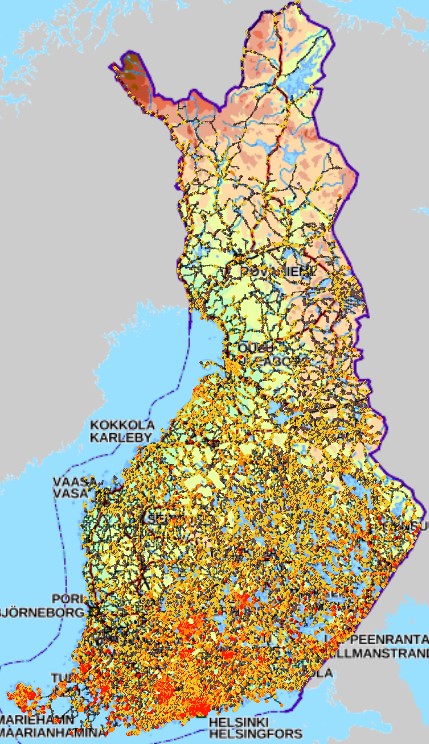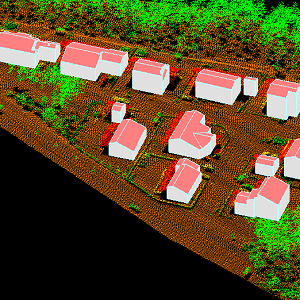dataset
Type of resources
Available actions
Topics
Keywords
Contact for the resource
Provided by
Years
Formats
Representation types
Update frequencies
status
Service types
Scale
Resolution
-
-
The EMODnet (European Marine Observation and Data network) Geology project collects and harmonizes marine geological data from the European sea areas to support decision making and sustainable marine spatial planning. The partnership includes 39 marine organizations from 30 countries. The partners, mainly from the marine departments of the geological surveys of Europe (through the Association of European Geological Surveys-EuroGeoSurveys), have assembled marine geological information at various scales from all European sea areas (e.g. the White Sea, Baltic Sea, Barents Sea, the Iberian Coast, and the Mediterranean Sea within EU waters). This dataset includes EMODnet seabed substrate maps at a scale of 1:5 000 from the European marine areas. Traditionally, European countries have conducted their marine geological surveys according to their own national standards and classified substrates on the grounds of their national classification schemes. These national classifications are harmonised into a shared EMODnet schema using Folk's sediment triangle with a hierarchy of 16, 7 and 5 substrate classes. The data describes the seabed substrate from the uppermost 30 cm of the sediment column. Further information about the EMODnet Geology project is available on the portal (http://www.emodnet-geology.eu/).
-

FIN Aineiston tarkoituksena on: -Identifioida tie- ja rata-alueet, joiden varrella esiintyy uhanalaisia ja silmälläpidettäviä lajeja -Identifioida tie- ja rata-alueet, joiden varrella esiintyy hyviä elinvoimaisia niittyindikaattorilajeja (hyönteisten mesi- ja ravintokasveja) -Identifioida tie- ja rata-alueet, joiden varrella esiintyy suojelualueita -Identifioida tie- ja rata-alueet, joiden varrella esiintyy komealupiinia tai kurtturuusua -Identifioida tie- ja rata-alueet, joiden varrella esiintyy komealupiinia tai kurtturuusua uhanalaisten lajien lisäksi -> Löytää herkät alueet ja paikallistaa vieraslajien uhka Tieto esitetään 1 kilometrin ruuduissa. Aineistosta on julkaistu kaksi erillistä versiota. -VaylanvarsienVieraslajitJaArvokkaatElinymparistot_avoin: Avoin versio, jonka lajitietoa on karkeistettu mahdollisista herkistä lajeista johtuen. Aineisto kuuluu SYKEn avoimiin aineistoihin (CC BY 4.0) ja sitä saa käyttää lisenssiehtojen mukaisesti -VaylanvarsienVieraslajitJaArvokkaatElinymparistot_kayttorajoitettu: Alkuperäinen karkeistamaton versio. Tämä versio on vain viranomaiskäyttöön eikä kyseistä aineistoa saa jakaa Aineistosta on tehty tarkempi menetelmäkuvaus https://geoportal.ymparisto.fi/meta/julkinen/dokumentit/VierasVayla_Menetelmakuvaus.pdf sekä muuttujaseloste https://geoportal.ymparisto.fi/meta/julkinen/dokumentit/VierasVayla_VariableDescription.xlsx ENG The purpose of the material is to: -Identify road and rail areas that have nearby observations of endangered and near threatened species -Identify road and rail areas with good meadow indicator plant species -Identify road and rail areas along which there are protected areas -Identify the road and rail areas along which there are observations of Lupinus polyphyllus or Rosa rugosa observations -Identify the road and rail areas along which there are Lupinus polyphyllus or Rosa rugosa observations in addition to sensitive species -> Finds sensitive areas and identify the overall threat of alien species The data is presented in 1-kilometer square grid cells. There are two separate versions of the data. -VaylanvarsienVieraslajitJaArvokkaatElinymparistot_avoin: Open access version, in which its species-related parts have been simplified due to data restriction issues. The material belongs to Syke's open materials (CC BY 4.0) and may be used in accordance with the license terms. -VaylanvarsienVieraslajitJaArvokkaatElinymparistot_kayttorajoitettu: Original version. This version is only for official use and the material in question may not be shared. A more precise description about the data procedures can be found from (In Finnish) https://geoportal.ymparisto.fi/meta/julkinen/dokumentit/VierasVayla_Menetelmakuvaus.pdf Furthermore, all the variables in the data are explained in this bilingual variable description https://geoportal.ymparisto.fi/meta/julkinen/dokumentit/VierasVayla_VariableDescription.xlsx This dataset was updated with the newest species observations on 10/2023 and 11/2024 Process code for this can be found from https://github.com/PossibleSolutions/VierasVayla_SpeciesUpdate
-
This dataset represents the Integrated biodiversity status assessment for fish used in State of the Baltic Sea – Second HELCOM holistic assessment 2011-2016. Status is shown in five categories based on the integrated assessment scores obtained in the BEAT tool. Biological Quality ratios (BQR) above 0.6 correspond to good status. The assessment is based on core indicators of coastal fish in coastal areas, and on internationally assessed commercial fish in the open sea. The open sea assessment includes fishing mortality and spawning stock biomass as an average over 2011–2016. Open sea results are given by ICES subdivisions, and are not shown where they overlap with coastal areas. Coastal areas results are given in HELCOM Assessment unit Scale 3 (Division of the Baltic Sea into 17 sub-basins and further division into coastal and off-shore areas) Attribute information: "COUNTRY" = name of the country / opensea "Name" = Name of the coastal assessment unit, scale 3 (empty for ICES open sea units) "HELCOM_ID" = ID of the HELCOM scale 3 assessment unit (empty for ICES open sea units) "EcoystemC" = Ecosystem component analyzed "BQR" = Biological Quality Ratio "Conf" = Confidence (0-1, higher values mean higher confidence) "Total_indi" = Number of HELCOM core indicators included (coastal assessment units) "F__of_area = % of area assessed "D1C2" = MSFD descriptor 1 criteria 2 "Number_of" = Number of open sea species included "Confidence" = Confidence of the assessment "BQR_Demer" = Demersal Biological Quality Ratio "F_spec_Deme" = Number of demersal species included "Conf_Demer" = Confidence for demersal species "BQR_Pelagi" = Pelagic Biological Quality Ratio "F_specPela" = Number of pelagic species included "Conf_Pelag" = Confidence for pelagic species "ICES_SD" = ICES Subdivision number "STATUS" = Integrated status category (0-0.2 = not good (lowest score), 0.2-0.4 = not good (lower score), 0.4-0.6 = not good (low score), 0.6-0.8 = good (high score, 0.8-1.0 = good (highest score))
-
KUVAUS Herkät vesistöt, joiden rajaus on luotu Viherkertoimen käyttöä varten. Viherkerroinmenetelmä on ekologinen suunnittelutyökalu tonttien viherpinta-alan arviointiin, minkä avulla etsitään vaihtoehtoisia ratkaisutapoja kaupunkivihreän lisäämiseen sekä hulevesien hallintaan. Määritellyillä alueilla huleveden laadulliseen hallintaan on kiinnitettävä erityistä huomiota. Aineisto perustuu hulevesiohjelmassa määritettyihin osavaluma-alueisiin, joiden avulla aineisto on rajattu. Aineisto on päivitetty 12/2023 vastaamaan uuden hulevesiohjelman valuma-alueita. Hulevesiohjelmaan liittyvän aineiston lisäksi rajausta on arvioitu asiantuntijoiden toimesta. KATTAVUUS Koko kaupunki PÄIVITYS Aineisto on laadittu viherkertoimen käyttöön ja päivittyy tiedon tarkentuessa. YLLÄPITOSOVELLUS Aineisto on tallennettu PostgreSQL-tietokantaan ja ylläpidetään QGIS-ympäristössä. KOORDINAATISTOJÄRJESTELMÄ Aineisto tallennetaan ETRS-GK24 (EPSG:3878) tasokoordinaattijärjestelmässä. GEOMETRIA Aluemainen SAATAVUUS Aineisto on saatavilla WFS- ja WMS2-rajapinnoilta. JULKISUUS, TIETOSUOJA. Avoin aineisto. VASTUUTAHO Ympäristönsuojeluyksikkö (ymparistonsuojelu@tampere.fi) KENTÄT vesisto: vesistöalueen nimi
-

The 3D vectors for buildings are three-dimensional instances of the Building target category in the National Topographic Database (KMTK). The 3D vectors are produced with a high degree of automation from laser scanning data 5 p based on 2D vectors for buildings in KMTK. For the time being, data is available only from a few example areas, but the coverage will be extended to the whole of Finland as the laser scanning programme proceeds. The product belongs to the open data of the National Land Survey of Finland.
-
The EMODnet (European Marine Observation and Data network) Geology project collects and harmonizes marine geological data from the European sea areas to support decision making and sustainable marine spatial planning. The partnership includes 39 marine organizations from 30 countries. The partners, mainly from the marine departments of the geological surveys of Europe (through the Association of European Geological Surveys-EuroGeoSurveys), have assembled marine geological information at various scales from all European sea areas (e.g. the White Sea, Baltic Sea, Barents Sea, the Iberian Coast, and the Mediterranean Sea within EU waters). This dataset includes EMODnet seabed substrate maps at a scale of 1:15 000 from the European marine areas. Traditionally, European countries have conducted their marine geological surveys according to their own national standards and classified substrates on the grounds of their national classification schemes. These national classifications are harmonised into a shared EMODnet schema using Folk's sediment triangle with a hierarchy of 16, 7 and 5 substrate classes. The data describes the seabed substrate from the uppermost 30 cm of the sediment column. Further information about the EMODnet Geology project is available on the portal (http://www.emodnet-geology.eu/).
-
The EMODnet (European Marine Observation and Data network) Geology project collects and harmonizes marine geological data from the European sea areas to support decision making and sustainable marine spatial planning. The partnership includes 39 marine organizations from 30 countries. The partners, mainly from the marine departments of the geological surveys of Europe (through the Association of European Geological Surveys-EuroGeoSurveys), have assembled marine geological information at various scales from all European sea areas (e.g. the White Sea, Baltic Sea, Barents Sea, the Iberian Coast, and the Mediterranean Sea within EU waters). This dataset includes EMODnet seabed substrate maps at a scale of 1:20 000 from the European marine areas. Traditionally, European countries have conducted their marine geological surveys according to their own national standards and classified substrates on the grounds of their national classification schemes. These national classifications are harmonised into a shared EMODnet schema using Folk's sediment triangle with a hierarchy of 16, 7 and 5 substrate classes. The data describes the seabed substrate from the uppermost 30 cm of the sediment column. Further information about the EMODnet Geology project is available on the portal (http://www.emodnet-geology.eu/).
-
-
 Paikkatietohakemisto
Paikkatietohakemisto